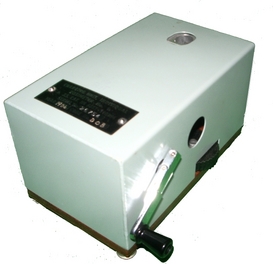PERSONAL PROTECTION
INDIVIDUAL DOSIMETER & CHARGING UNIT
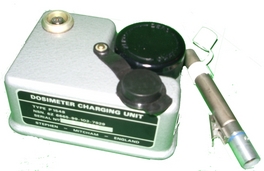
[1]
The individual dosimeter is designed to measure the accumulated dose of gamma (or X) radiation received by an individual over a period of time. The dosimeter can be read at any time and is small and light enough to be clipped onto clothing or carried in a pocket. The dosimeter is similar in size to a pen and within the barrel contains the ionization chamber, quartz-fibre electroscope and charging pin assemblies.The upper portion of the dosimeter contains a scale and a magnifying lens.
When the dosimeter is charged using the charging unit, the quartz-fibre moves away from its supporting wire so that looking through the scale it moves towards zero. When correctly charged it will be seen to rest on the zero mark. The effect of radiation on the ionization chamber is to make the air inside it, normally a good one, a poor one. This causes some of the charge on the electroscope to leak away, allowing the quartz-fibre to move back towards its supporting wire and so up the scale from zero.The stronger the radiation or the longer the exposure to radiation, the greater will be the reduction of the charge and the higher will be the reading on the scale.
When the dosimeter is charged using the charging unit, the quartz-fibre moves away from its supporting wire so that looking through the scale it moves towards zero. When correctly charged it will be seen to rest on the zero mark. The effect of radiation on the ionization chamber is to make the air inside it, normally a good one, a poor one. This causes some of the charge on the electroscope to leak away, allowing the quartz-fibre to move back towards its supporting wire and so up the scale from zero.The stronger the radiation or the longer the exposure to radiation, the greater will be the reduction of the charge and the higher will be the reading on the scale.
|
The charging unit is a portable hand-operated instrument designed for charging the quartz-fibre dosimeters. Two general kinds are used and examples are shown in the pictures above and right.
Both charging units work in a similar way. The image above shows a later style battery operated unit whilst the picture right shows a wind-up version. In both cases the dosimeter is inserted into the docking area and charge is generated from either the battery or by winding up the device. Once charge has built up then it is transferred to the dosimeter through a rotating switch which will charge or discharge the dosimeter depending upon the direction of the rotation |
CONTAMINATION METER No.1
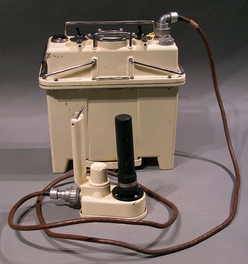
[2]
The first large scale British civil defence issue was the Geiger-Müller counter Meter, Contamination, No. 1 set - stock number 5CG0012, of 1953. It had 0 - 10 mR/hour range with external probe and headphones. This was designed to use two 150 volt batteries, although later they were fitted with an inverter which used four 1.35 volt mercury cells or, alternatively, a mains electricity power pack. Many of these units remained in service until the 1980s. There was also a Mk. 2 model which used rubber connectors and cable for the probe unit, compared to the Plessey connectors of the Mk.1. This used cold-cathode valves and very high impedance circuitry throughout to extend useful battery life as long as possible with the existing technology.
Source: Andy Cowley via Wikipedia
RADIAC SURVEY METER
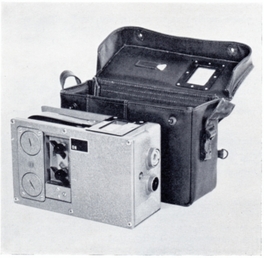
[3]
The Radiac Survey Meter No 2 or RSM was a 1955 meter which counted the particles produced by radioactive decay. Having been superseded within the ROC by the Fixed Survey Meter the RSM remained in use only for post attack mobile monitoring missions in a post attack period.
PORTABLE DOSE RATE METER (PDRM-82M)
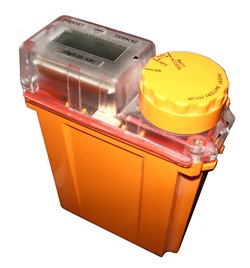
[1]
The PDRM82 was the standard portable version of the new meters, that were manufactured by Plessey and introduced in 1982. The unit gave more accurate readings and using standard 'C' cell torch batteries that lasted many times longer, up to 400 hours of operation. The compact and robust instruments were housed in sturdy orange coloured polycarbinate cases and had clear liquid crystal displays. The radiac sensor was self contained within the casing. All the electronics including miniature geiger tube (shielded against beta particles) was incorporated onto a single EMP-hardened, PCB. It is microprocessor controlled with digital readout.
For use by the Royal Observer Corps the instrument was also provided in the fixed version designated the PDRM82(F). The fixed version had an external coaxial socket mounted on its rear, that accepted a cable from the above ground ionisation detector under a polycarbinate dome. For training purposes timed simulated readings could be fed to the meter from an Eprom.
For use by the Royal Observer Corps the instrument was also provided in the fixed version designated the PDRM82(F). The fixed version had an external coaxial socket mounted on its rear, that accepted a cable from the above ground ionisation detector under a polycarbinate dome. For training purposes timed simulated readings could be fed to the meter from an Eprom.
Information Source:
[1] South Yorkshire ROC Collection
[2] Wikipedia
[3] ROC Training Manual
